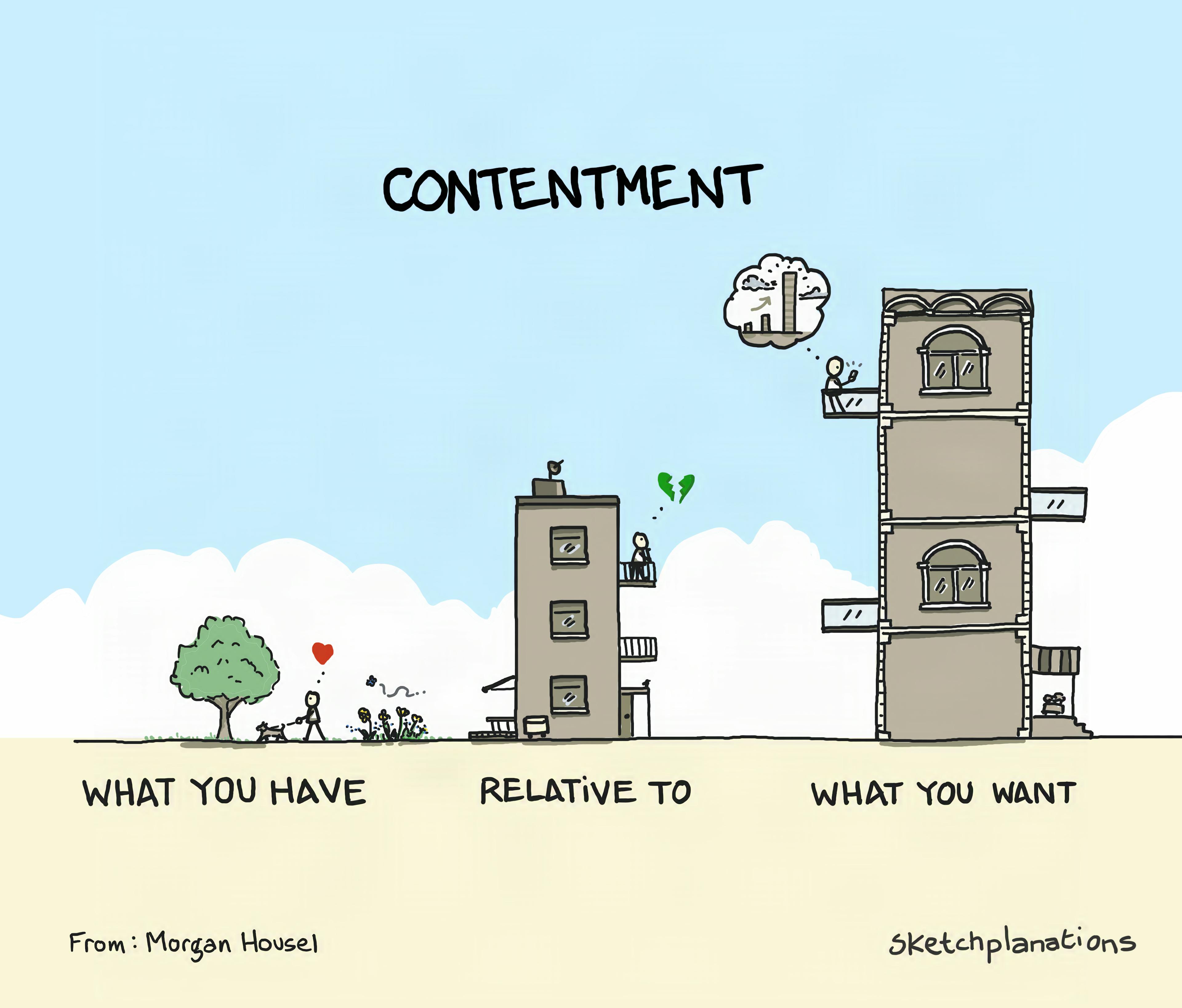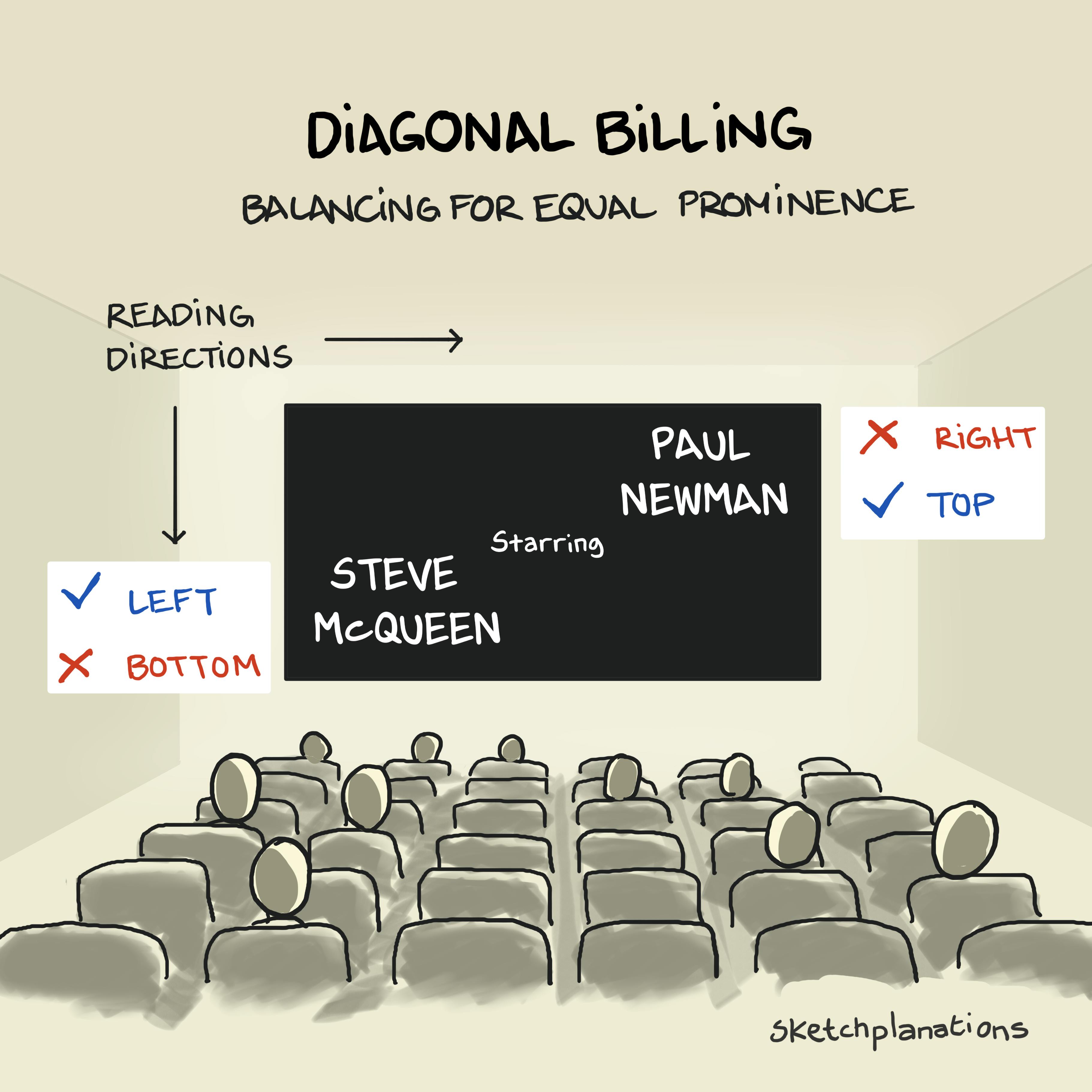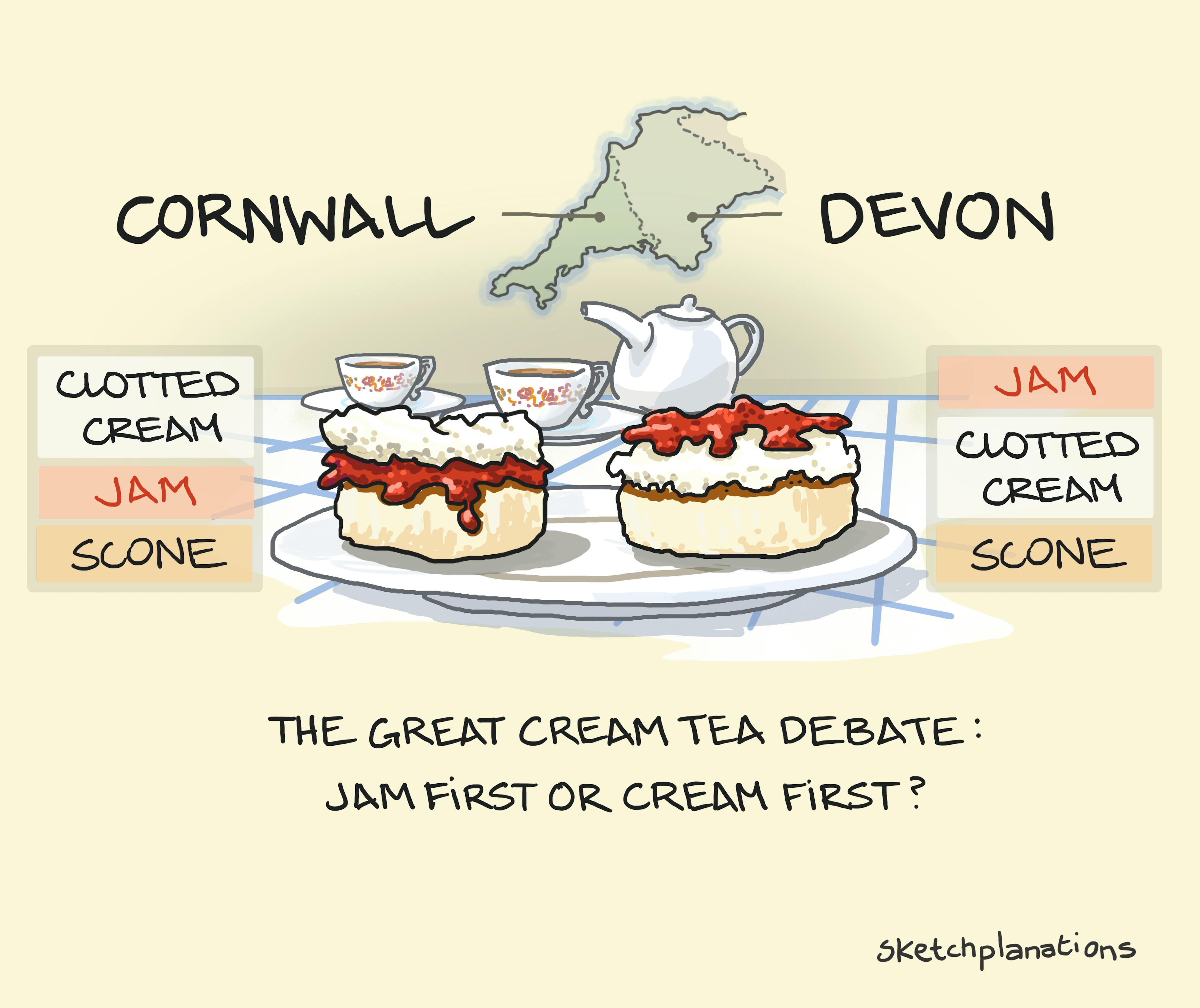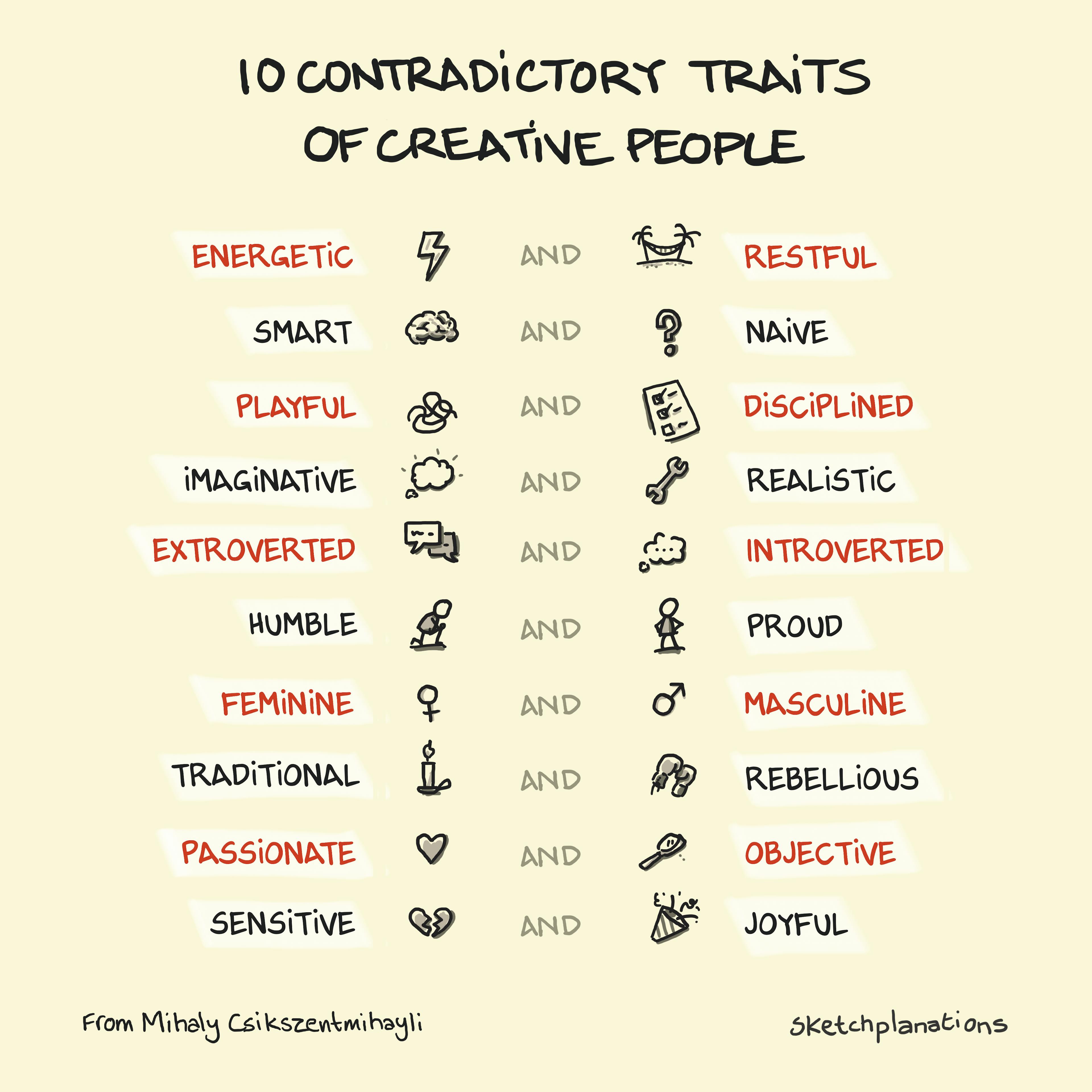Creative people display contradictory personality traits. This finding has stuck with me since I read it over 20 years ago in psychologist Mihaly Csikszentmihalyi’s book Creativity: Flow and the Psychology of Discovery and Invention. Csikszentmihalyi drew this finding from over 100 interviews with exceptional people—engineers, writers, historians, chemists, musicians, business people and more—and his lifetime of research into psychology, happiness, and flow. Alongside dismantling several myths surrounding creativity, such as the tortured genius, Mihalyi explores the central idea that creative people do not lean only toward one side or the other on a range of personality traits. Instead, creative people will display quite opposite characteristics at different times, or even at the same time. The 10 Contradictory Traits of Creative People Creative people often display both sides of these traits: Energetic and Restful Smart and Naive Playful and Disciplined Imaginative and Realistic Extroverted and Introverted Humble and Proud Feminine and Masculine Traditional and Rebellious Passionate and Objective Sensitive and Joyful The Importance of Contradiction This idea of contradictory personality traits was exciting to me when I read about it. I was a young design and engineering graduate learning and applying the Theory of Inventive Problem-Solving (TRIZ) for what seemed like creative solutions. I was fascinated with where ideas come from, what creative people do differently, and how I could become one. A fundamental idea in TRIZ is that solutions evolve through the resolution of contradictions. For example, you want a tent to be strong and sturdy so it doesn’t blow over or break. The standard approach for this makes it heavier. But you also want it to be lightweight to carry. How can it be both strong and lightweight? Enter creative solutions. Compromise and trade-off are sometimes necessary, but whenever you find what seems a truly creative solution, you’ll usually find that someone’s resolved a contradiction at its core. And here was Mihaly Csikszentmihalyi finding that creative people benefit not just from being imaginative, but also, at times, from being realistic. Not just smart, but also, at times, naive. Resolving a contradiction of personality. Resisting Labelling Labelling others or yourself usually seems to me a misguided and often harmful act. For example, attribution bias is the tendency to attribute behaviour to fixed personality traits rather than to circumstances or actions. Considering someone a genius, a loser, or a natural artist, without considering the circumstances and actions that got them where they are, gets us off the hook. As David Macauley pointed out (video), when people say they can’t draw, they’ve usually never really tried. The idea of displaying contradictory or paradoxical traits was very freeing to me. To be creative, you don’t have to be this or that. You can be this at times and that at times. And perhaps this fluidity helps us towards creative insights. I generally consider myself fairly introverted—I easily recharge through time by myself—but in the right company and the right time, I can appear quite extroverted. The smartest people can also ask naive questions. Being proud and confident can help try things that others won’t. And being humble enables you to accept help and ideas from others, and not drive collaborators away. At times, you may be energetic and productive; at other times, you may want to rest and recharge. We don’t have to be one or the other. We can be open to being both. Excerpt on Creative Individuals and Complex Personalities Here’s Csikszentmihalyi from the book: “Are there no traits that distinguish creative people? If I had to express in one word what makes their personalities different from others, it would be complexity. They show tendencies of thought and action that in most people are segregated. They contain contradictory extremes – instead of being an ‘individual’, each of them is a ‘multitude’. These qualities are present in all of us, but usually we are trained to develop only one pole of the dialectic. We might grow up cultivating the aggressive, competitive side of our nature, and disdain or repress the nurturant, cooperative side. A creative individual is more likely to be both aggressive and cooperative, either at the same time or at different times, depending on the situation. Having a complex personality means being able to express the full range of traits that are potentially present in the human repertoire. Creative individuals have a great deal of physical energy, but they are also often quiet and at rest. Creative individuals tend to be smart, yet also naive at the same time. A third paradoxical trait refers to the related combination of playfulness and discipline, or responsibility and irresponsibility. Creative individuals alternate between imagination and fantasy at one end, and a rooted sense of reality at the other. Creative people seem to harbor opposite tendencies on the continuum between extroversion and introversion. Creative individuals are also remarkably humble and proud at the same time. Creative individuals to a certain extent escape this rigid gender role stereotyping [of ‘masculine’ and ‘feminine’]. Creative people are both traditional and conservative and at the same time rebellious and iconoclastic. Creative persons are very passionate about their work, yet they can be extremely objective about it as well. The openness and sensitivity of creative individuals often exposes them to suffering and pain yet also a great deal of enjoyment.” Related Ideas to 10 Paradoxical Traits of Creative People Also see: Thesis, Antithesis, Synthesis Everyone’s a Geek About Something, and no one is one-dimensional, as I like to say The Spectrum Policy Attribution Bias Flow Match challenge with skills for flow at work Yes sayers, no sayers The Bandwagon Effect Groupthink The same excerpt above is also in the excellent Farnum Street.Creative people display contradictory personality traits. This finding has stuck with me since I read it over 20 years ago in psychologist Mihaly Csikszentmihalyi’s book Creativity: Flow and the Psychology of Discovery and Invention. Csikszentmihalyi drew this finding from over 100 interviews with exceptional people—engineers, writers, historians, chemists, musicians, business people and more—and his lifetime of research into psychology, happiness, and flow. Alongside dismantling several myths surrounding creativity, such as the tortured genius, Mihalyi explores the central idea that creative people do not lean only toward one side or the other on a range of personality traits. Instead, creative people will display quite opposite characteristics at different times, or even at the same time. The 10 Contradictory Traits of Creative People Creative people often display both sides of these traits: Energetic and Restful Smart and Naive Playful and Disciplined Imaginative and Realistic Extroverted and Introverted Humble and Proud Feminine and Masculine Traditional and Rebellious Passionate and Objective Sensitive and Joyful The Importance of Contradiction This idea of contradictory personality traits was exciting to me when I read about it. I was a young design and engineering graduate learning and applying the Theory of Inventive Problem-Solving (TRIZ) for what seemed like creative solutions. I was fascinated with where ideas come from, what creative people do differently, and how I could become one. A fundamental idea in TRIZ is that solutions evolve through the resolution of contradictions. For example, you want a tent to be strong and sturdy so it doesn’t blow over or break. The standard approach for this makes it heavier. But you also want it to be lightweight to carry. How can it be both strong and lightweight? Enter creative solutions. Compromise and trade-off are sometimes necessary, but whenever you find what seems a truly creative solution, you’ll usually find that someone’s resolved a contradiction at its core. And here was Mihaly Csikszentmihalyi finding that creative people benefit not just from being imaginative, but also, at times, from being realistic. Not just smart, but also, at times, naive. Resolving a contradiction of personality. Resisting Labelling Labelling others or yourself usually seems to me a misguided and often harmful act. For example, attribution bias is the tendency to attribute behaviour to fixed personality traits rather than to circumstances or actions. Considering someone a genius, a loser, or a natural artist, without considering the circumstances and actions that got them where they are, gets us off the hook. As David Macauley pointed out (video), when people say they can’t draw, they’ve usually never really tried. The idea of displaying contradictory or paradoxical traits was very freeing to me. To be creative, you don’t have to be this or that. You can be this at times and that at times. And perhaps this fluidity helps us towards creative insights. I generally consider myself fairly introverted—I easily recharge through time by myself—but in the right company and the right time, I can appear quite extroverted. The smartest people can also ask naive questions. Being proud and confident can help try things that others won’t. And being humble enables you to accept help and ideas from others, and not drive collaborators away. At times, you may be energetic and productive; at other times, you may want to rest and recharge. We don’t have to be one or the other. We can be open to being both. Excerpt on Creative Individuals and Complex Personalities Here’s Csikszentmihalyi from the book: “Are there no traits that distinguish creative people? If I had to express in one word what makes their personalities different from others, it would be complexity. They show tendencies of thought and action that in most people are segregated. They contain contradictory extremes – instead of being an ‘individual’, each of them is a ‘multitude’. These qualities are present in all of us, but usually we are trained to develop only one pole of the dialectic. We might grow up cultivating the aggressive, competitive side of our nature, and disdain or repress the nurturant, cooperative side. A creative individual is more likely to be both aggressive and cooperative, either at the same time or at different times, depending on the situation. Having a complex personality means being able to express the full range of traits that are potentially present in the human repertoire. Creative individuals have a great deal of physical energy, but they are also often quiet and at rest. Creative individuals tend to be smart, yet also naive at the same time. A third paradoxical trait refers to the related combination of playfulness and discipline, or responsibility and irresponsibility. Creative individuals alternate between imagination and fantasy at one end, and a rooted sense of reality at the other. Creative people seem to harbor opposite tendencies on the continuum between extroversion and introversion. Creative individuals are also remarkably humble and proud at the same time. Creative individuals to a certain extent escape this rigid gender role stereotyping [of ‘masculine’ and ‘feminine’]. Creative people are both traditional and conservative and at the same time rebellious and iconoclastic. Creative persons are very passionate about their work, yet they can be extremely objective about it as well. The openness and sensitivity of creative individuals often exposes them to suffering and pain yet also a great deal of enjoyment.” Related Ideas to 10 Paradoxical Traits of Creative People Also see: Thesis, Antithesis, Synthesis Everyone’s a Geek About Something, and no one is one-dimensional, as I like to say The Spectrum Policy Attribution Bias Flow Match challenge with skills for flow at work Yes sayers, no sayers The Bandwagon Effect Groupthink The same excerpt above is also in the excellent Farnum Street.WWW
Read more…







